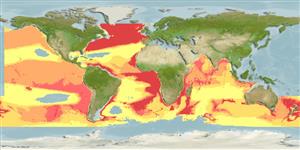Preferred temperature (Ref.
123201): 1.9 - 4.6, mean 2.9 °C (based on 4347 cells).
Phylogenetic diversity index (Ref.
82804): PD
50 = 0.7500 [Uniqueness, from 0.5 = low to 2.0 = high].
Bayesian length-weight: a=0.00331 (0.00267 - 0.00411), b=3.15 (3.08 - 3.22), in cm total length, based on LWR estimates for this species (Ref.
93245).
Niveau trophique (Ref.
69278): 3.6 ±0.47 se; based on food items.
Résilience (Ref.
120179): Très faible, temps minimum de doublement de population supérieur à 14 ans (K=0.05-1.0; tm=15; tmax=44).
Fishing Vulnerability (Ref.
59153): High to very high vulnerability (70 of 100).
Climate Vulnerability (Ref.
125649): Moderate vulnerability (38 of 100).
Nutrients (Ref.
124155): Calcium = 19.8 [5.7, 48.2] mg/100g; Iron = 0.264 [0.114, 0.738] mg/100g; Protein = 17.6 [15.8, 19.4] %; Omega3 = 0.114 [0.044, 0.291] g/100g; Selenium = 25.8 [8.1, 70.4] μg/100g; VitaminA = 19.4 [2.2, 160.1] μg/100g; Zinc = 0.507 [0.276, 1.026] mg/100g (wet weight);
